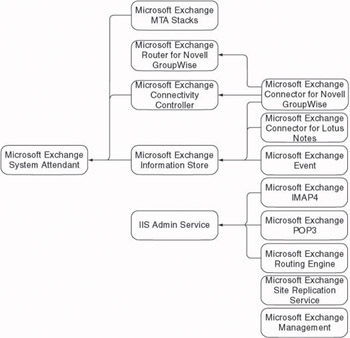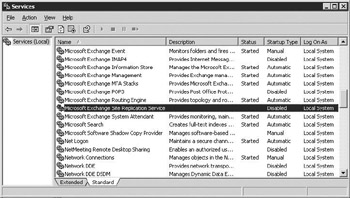5.2 Managing Exchange services
|
| < Day Day Up > |
|
Exchange is not a single, monolithic, executable image running on your server. Instead, Exchange is a collection of cooperating services. Table 5.1 lists these Exchange services and the other prerequisite services that also must be running. Exchange 2003 has flattened the dependency hierarchy of Exchange services so that the protocol services are no longer dependent on the Information Store service. This allows administrators to bring the Exchange store online and offline in parallel with the protocols.
| Service | Function | Service Name/Executable | Required Service |
|---|---|---|---|
| Microsoft Exchange Connectivity Controller | Provides support services for Microsoft Exchange connectors | MSExchangeCoCo Iscntrl.exe | Event Log Microsoft Exchange System Attendant |
| Microsoft Exchange Connector for Lotus Notes | Allows sharing of mail traffic with Lotus Notes systems | LME-NOTES dispatch.exe | Event Log Microsoft Exchange Connectivity Controller Microsoft Exchange Information Store |
| Microsoft Exchange Connector for Novell GroupWise | Allows sharing of mail traffic with Novell Group Wise systems | LME-GWISE dispatch.exe | Event Log Microsoft Exchange Connectivity Controller Microsoft Exchange Information Store Microsoft Exchange Router for Novell GroupWise |
| Microsoft Exchange Event | Monitors folders and fires events for Exchange 5.5-compatible server applications | MSExchangeES events.exe | Microsoft Exchange Information Store |
| Microsoft Exchange IMAP4 | Provides IMAP4 services | IMAP4Svc inetinfo.exe | IIS Admin Service |
| Microsoft Exchange Information Store | Manages the Information Storage; if this service is stopped, mailbox stores and public folder stores are unavailable | MSExchangeIS store.exe | EXIFS Microsoft Exchange System Attendant |
| Microsoft Exchange Management | Provides Exchange management information using WMI | MSExchangeMGMT exmgmt.exe | Remote Procedure Call (RPC) Windows Management Instrumentation |
| Microsoft Exchange MTA Stacks | Provides X.400 services | MSExchangeMTA emsmta.exe | Microsoft Exchange System Attendant |
| Microsoft Exchange POP3 | Provides POP3 services | POP3Svc inetinfo.exe | IIS Admin Service |
| Microsoft Exchange Router for Novell GroupWise | Provides support for scheduling collaboration with Novell GroupWise systems | MSExchangeGWRtr gwrouter.exe | Event Log |
| Microsoft Exchange Routing Engine | Provides topology and routing information | RESvc inetinfo.exe | IIS Admin Service |
| Microsoft Exchange Site Replication Service | Emulates Exchange 5.5 directory service | MSExchangeSRS srsmain.exe | |
| Microsoft Exchange System Attendant | Provides monitoring, maintenance, and Active Directory lookup services | MSExchangeSA mad.exe | Event Log NT LM Security Support Provider Remote Procedure Call (RPC) Server Workstation |
| IIS, Internet Information Server; IMAP, Internet Mail Access Protocol; MTA, Message Transfer Agent; POP, Post Office Protocol | |||
In addition to the Exchange services, several non-Exchange services are important for Exchange. Some of these are listed in Table 5.2
| Service | Function | Service Name/Executable | Required Service |
|---|---|---|---|
| Event Log | Enables event log messages to be viewed in Event Viewer | Eventlog services.exe | |
| IIS Admin Service | Allows web and FTP service administration using the IIS snap-in | IISADMIN inetinfo.exe | Remote Procedure Call (RPC) Security Accounts Manager |
| Microsoft Active Directory Connector | Replicates objects from the Exchange 5.5 directory into the Active Directory for use by Exchange 2003 | MSADC adc.exe | Event Log NT LM Security Support Provider Remote Procedure Call (RPC) Server Workstation |
| Network News Transport Protocol (NNTP) | Transports network news across the network | NntpSvc inetinfo.exe | EventLog IISAdmin Service |
| NT LM Security Support Provider | Provides security to RPC programs that use transports other than named pipes | NtLmSsp lsass.exe | |
| Remote Procedure Call (RPC) | Serves as the end- point mapper and COM Service Control Manager | RpcSs svchost.exe | |
| Server | Supports file, print, and named-pipe sharing over the network | lanmanserver svchost.exe | |
| Simple Mail Transport Protocol (SMTP) | Transports electronic mail across the network | SMTPSVC inetinfo.exe | Event Log IIS Admin Service |
| Windows Management Instrumentation | Provides a common interface and object model to access management information about applications and services | winmgmt svchost.exe | Event Log Remote Procedure Call (RPC) |
| Workstation | Creates and maintains client network connections to remote servers | lanmanworkstation svchost.exe | |
| IIS, Internet Information Services | |||
5.2.1 Starting Exchange services
Certain Exchange services depend on other Exchange services. If these services are started out of order, the needed services will automatically be started. For example, if an attempt is made to start the Information Store before the System Attendant, the Windows service manager will automatically start the System Attendant. These prerequisite services are shown in Figure 5.5.

Figure 5.5: Exchange service dependencies
By default, most Exchange services are configured to automatically start when the server is rebooted. However, there may be times when the services will need to be started manually. The following procedure can be used to start the Exchange services:
-
Begin from the Windows Start menu by selecting All Programs →Administrative Tools →Services (Figure 5.6).

Figure 5.6: Services dialog box -
Right-click on the service you want to start, and select Start to start the service.
-
Right-click on any other services you want to start, and select Start to start the service.
-
Use the Windows Event Viewer to ensure that all of the services started. You can start the Event Viewer by selecting All Programs →Administrative Tools →Event Viewer from the Windows Start menu. Exchange events are listed in the Application Log. Table 5.3 contains a list of the event IDs that correspond to successful service startups.
| Service | Event Source | Event ID |
|---|---|---|
| Microsoft Active Directory Connector | MSADC | 8001 |
| Microsoft Exchange Management | MSExchangeMGMT | 3 |
| Microsoft Exchange Connectivity Controller | MSExchangeCoCo | 8229 |
| Microsoft Exchange Connector for Lotus Notes | MSExchangeNOTES | 8229 |
| Microsoft Exchange Connector for Novell GroupWise | MSExchangeGWISE | 8229 |
| Microsoft Exchange Event | MSExchangeES | 0 |
| Microsoft Exchange IMAP4 | IMAP4Svc | 1033 |
| Microsoft Exchange Information Store | MSExchangeIS Mailbox MSExchangeIS Public MSExchangeIS | 9523 9523 001 |
| Microsoft Exchange MTA Stacks | MSExchangeMTA | 9298 |
| Microsoft Exchange POP3 | POP3Svc | 1003 |
| Microsoft Exchange Router for Novell GroupWise | MSExchangeGWRtr | 6015 |
| Microsoft Exchange Routing Engine | MSExchange Transport | 1005 |
| Microsoft Exchange System Attendant | MSExchangeSA | 9014 |
If a service fails to start, wait a few minutes and try again. A common cause of failures is that the service is dependent on another service that has not finished starting. Waiting a few minutes allows these services to finish. Check to ensure that all the necessary services have been started. Try to start the service several times before assuming failure.
Sometimes the Exchange server is simply in a state where a reboot is required, so reboot and try again before assuming the service has failed. If all attempts to start the service fail, it may still be possible to run the service as an application. Running the service as an application also usually has the advantage of producing more detailed error reporting. This is an acceptable short-term solution while continuing to investigate the problem. The event log will record at least one event for any service start failures. The event will provide a starting point for troubleshooting.
A common cause for many service start failures is that the Exchange service-account permissions cannot be validated. If the Microsoft Exchange Information Store service will not start, it may be in a state of recovery. A normal recovery takes from 5 to 50 minutes, depending on the number of log files. Check the event viewer to verify that recovery is taking place.
If the Microsoft Exchange System Attendant will not start, check the event viewer to make sure that the network and related services are working properly. The network services must be running before the System Attendant will start.
5.2.2 Stopping Exchange services
Exchange services should be stopped cleanly if an Exchange server needs to be restarted. This will ensure that the Exchange databases are stopped properly and that the databases are left in a consistent state.
Because many Exchange services are dependent on the Microsoft Exchange System Attendant, it is possible to quickly stop many Exchange services simply by stopping the System Attendant. However, if you are having system problems, stopping the services one at a time may help to identify the source of the problem and may improve the likelihood that the server will restart successfully.
Patience is important. The Information Store service must commit all outstanding transactions to the database. If a service, such as the Information Store, takes an unusually long time to stop, it is often difficult to tell if there is a problem or if the service simply needs more time to complete. You can use the Windows Performance Monitor to determine whether the service is still attempting to stop or if it has encountered an unexpected error. If the process time for the service is nonzero, it is possible that the service is still attempting to stop, and more patience is required. It is not uncommon for this to take as long as 30 minutes. If you prematurely abort a service stop or if the service hangs, the service will be left in an unknown state.
You can use the following procedure to stop Exchange services:
-
Begin from the Windows Start menu by selecting All Programs →Administrative Tools →Services.
-
Right-click on the service you want to stop, and select Stop to stop the service.
-
Right-click on any other services you want to stop, and select Stop to stop the service.
-
Use the Windows Event Viewer to ensure that all of the services stopped. You can start the Event Viewer by selecting All Programs →Administrative Tools →Event Viewer from the Windows Start menu. Exchange events are listed in the Application Log. Table 5.4 contains a list of the event IDs that correspond to successful service stop events.
Table 5.4: Service Stop Event Numbers Service
Event Source
Event ID
Microsoft Active Directory Connector
MSADC
8002
Microsoft Exchange Management
MSExchange MGMT
5
Microsoft Exchange Connectivity Controller
MSExchangeCoCo
8230
Microsoft Exchange Connector for Lotus Notes
MSExchangeNOTES
8230
Microsoft Exchange Event
MSExchangeES
1
Microsoft Exchange IMAP4
IMAP4Svc
1035
Microsoft Exchange Information Store
MSExchangeIS Mailbox MSExchangeIS Public
9539
9539
Microsoft Exchange MTA Stacks
MSExchangeMTA
9299
Microsoft Exchange POP3
POP3Svc
1035
Microsoft Exchange Router for Novell GroupWise
MSExchangeGWRtr
6016
Microsoft Exchange Routing Engine
MSExchange Transport
1004
Microsoft Exchange System Attendant
MSExchangeSA
9016
IMAP, Internet Mail Access Protocol; MTA, message transfer agent; POP, Post Office Protocol
|
| < Day Day Up > |
|
EAN: 2147483647
Pages: 128